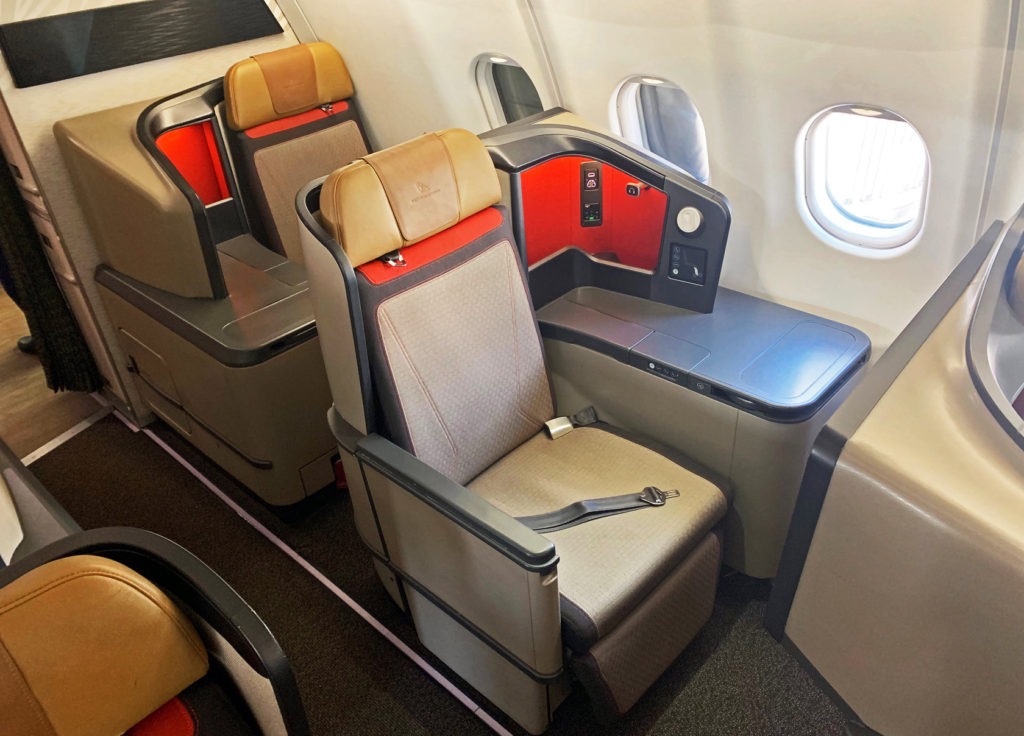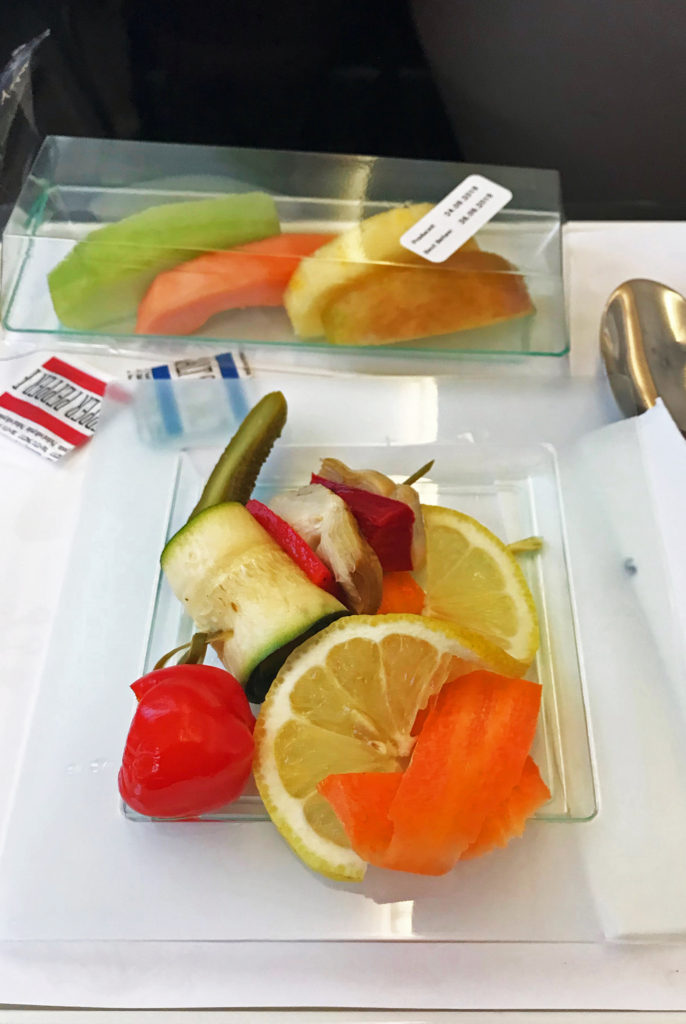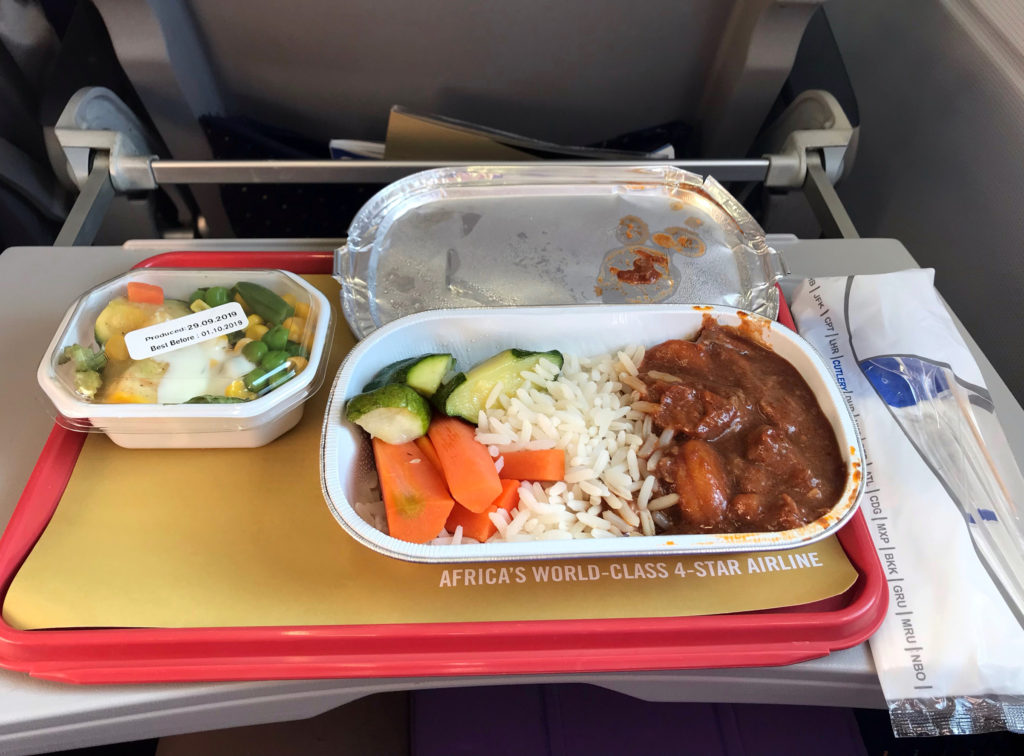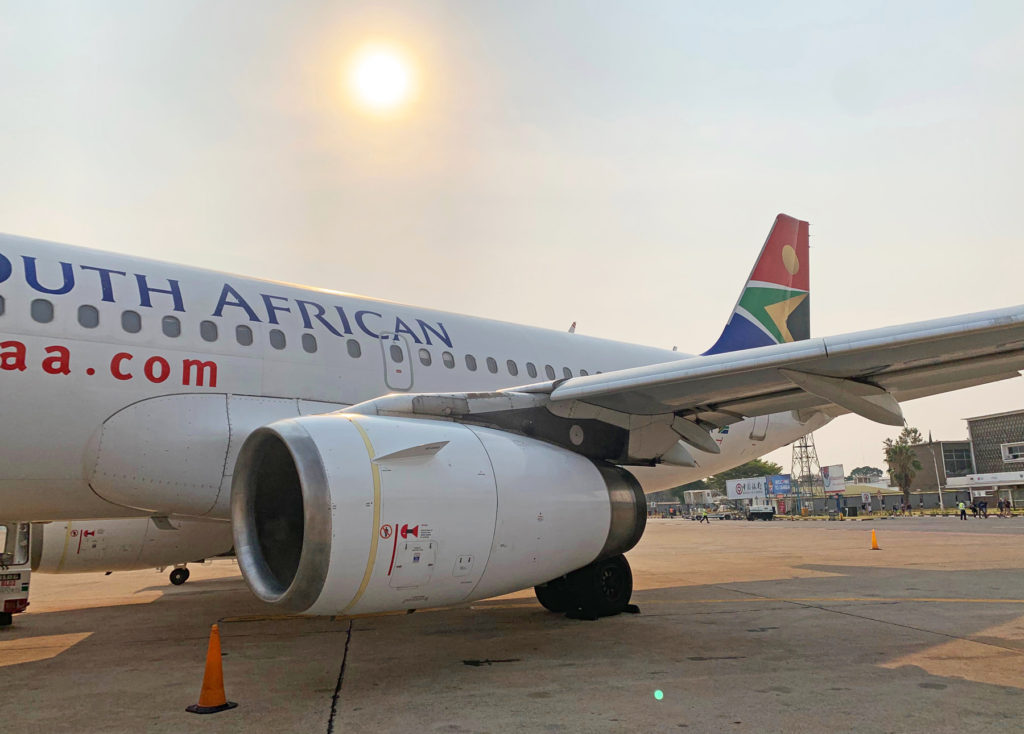WHEN IS economy class better than business class? Never, basically. The distinctions, though, can sometimes be blurry, particularly on shorter flights. Which brings us to a pair of intra-Africa hops I took recently with South African Airways.
Logistically the flights were similar. Both were international but brief sectors, at about 90 minutes each. The first was aboard a widebody Airbus A330; the second on a much smaller, single-aisle A319. Now, any flight review comes with a critical disclaimer: experiences can very tremendously from one flight to the next. A terrible flight on Tuesday could be a wonderful flight on Wednesday, depending on everything from who’s sitting beside you to the temperament of your particular crew. Duly noted, but would you believe that coach on an A319 could be a better experience, and certainly a better value, than business on an A330?
Business class, Johannesburg (JNB) to Victoria falls, Zimbabwe (VFA). Airbus A330-300.
Like any premium class experience, this one started in the lounge. South African has two lounges in the international wing at JoBurg’s O.R. Tambo International Airport, named “Platinum” and “Premium.” The former is reserved for high-level frequent flyers, so for us it was the latter. Walking past the smoked-glass entry to the Platinum room, not to mention the luxe facade of the Emirates lounge just down the hall, it was easy to feel envious. But the Premium lounge was a more than comfy respite after the hectic immigration and security lines. It’s a bright, amply appointed space with plenty of seats and a sweeping view of the apron. This was a morning departure, and the buffet had all the breakfast fare you’d expect, both hot and cold. And maybe the best surprise of all, there were no shrieking kids or other obnoxious patrons.
Boarding, on the other hand, was noisy and chaotic, as it always is, with people ignoring the zone calls and crowding around the doorway and podium. (Something desperately needs to be done, industry-wide, about the boarding crush.) A placard indicated a priority lane for business class, but getting there meant pushing our way through a scrum of heedless passengers. When we finally stepped into the plane, the sudden peace and quiet was palpable.
The business cabin had 46 sleeper pods in a 1-2-1 configuration. This is South African’s top-of-the-line product. Not even its A340s, used on its longest intercontinental routes, have these seats, using a much tighter six-abreast layout instead. I was struck by the colors: sandy tones accented with red and silver. It was one of the more attractive cabins I’ve seen in some time, and the feel was warm and inviting. A shoulder panel featured all the usual mod cons: AC and USB ports, a reading lamp, seat controls, and a storage nook.
There was no amenities kit of any kind, though, and the headset compartment was empty. And the lack of a headset rendered my 15-inch video screen all but useless. Granted, this was a long-haul aircraft filling the gap on a quick morning turn between runs to Accra, Lagos or wherever, and we weren’t gonna get all the frills. That’s to be expected, and a missing amenities bag and headset aren’t much of a penalty on a flight so short. Nonetheless, it seemed a little… skimpy. I settled in, looking forward, at least, to a glass of champagne.

Seat 5A on the A330.
Except, there wasn’t any. Indeed, this goes down as the first time I’ve ever sat in business class and was not offered any type of pre-departure beverage. No champagne, no juice, nothing. Quite peculiar.
After takeoff I switched on my screen. The remote control device was cumbersome to manipulate, but after a few minutes of fumbling I managed to pull up the moving map display, tracking our progress as we crossed from South Africa into Botswana, taking in a sunny view of the Limpopo River and Botswana’s Makgadikgadi salt pan, where I visited some years ago.
A short while later a breakfast was served. Or snack, maybe, is the appropriate word. There was no printed menu, so I’m unsure what the airline called this particular entree, but imagine a cold, saucer-sized plate of sliced tomato, pepper, mushroom and cheese. It sounds better than it was. Julia had gone for the vegetarian option, which was far worse. In fact, it may have been the worst meal I’ve ever seen served on a plane: a plastic box of cast-off fruits and veggies featuring a deflated tomato, carrot shavings, a dehydrated pickle and lemon slices.
And the strangeness of the lack of a pre-departure drink was outdone only by a lack of wine once aloft. Drink options were restricted to coffee, juice, and soda. Again, very unusual. There was no hot towel service, either.
By the time we touched down at Vic Falls, I was bored and eager to disembark. This is not my usual feeling when traveling in premium class. If an airline is doing it right, you don’t want to get off. With a flying time of an hour-and-a-half, I didn’t expect the same service I’d get on a transoceanic flight. Still, this was a widebody plane on an international sector, however short, and the global standard — at least on legacy carriers outside the United States — is a higher one. It was a perfectly relaxing flight, but underwhelming just the same, especially at a price that was double the economy fare.

You call this business class?
Economy class, Lusaka, Zambia (LUN) to Johannesburg (JNB). Airbus A319.
Imagine my surprise, then, when the second leg, from the Zambian capital of Lusaka back to JoBurg, turned out to be more enjoyable. In economy class, no less, on a much smaller plane. Had the seat next to me not been empty, or had the flight been longer, the take-away might not be as positive. But the seat was empty, and it was a short flight — a surprisingly pleasant one that managed to throw the shortcomings of the first one into starker relief.
There were no jet bridges at LUN, and the aircraft was parked a good distance from the gate. While it might seem a silly thing, I appreciated the chance to walk to the jet, by way of a marked pathway that ran along the inside of the apron, rather than be forced into a jam-packed bus, which is usually how it works with remote parking. And I always thrill at the chance to board via old-timey air-stairs rather than through a window-less tube. I fully understand the negatives of stairs, but here’s something dramatic about stepping onto a plane that way: the ground-level approach along the tarmac followed by the slow ascent. The effect is like the opening credits of a film.
My big gripe was the hideously long check-in queue and disorganized boarding lounge, which probably had more to do with poor design than any failure on SAA’s part (a new, Chinese-built terminal is opening at LUN soon). I’ll also dock some points for the absence of any seat-back video on the A319. On the plus side, however, the 32-inch pitch felt unusually generous, cabin staff were extra-friendly, and the meal — a hot chicken and pasta dish — was five times better than the weird little pile of tomatoes and peppers I’d picked at on the way to Vic Falls.
And what’s this, complimentary wine! That Victoria Falls is predominately a leisure market might explain some of what happened on the A330, but let me get this straight: we were served complimentary wine in economy class, yet not in business, on what were otherwise identical routes? Talk about a head-scratcher.
For the price ($180), I got what I paid for and a little bit more. And isn’t that what it’s all about: expectation? This cannot be said for the first leg. Pretty much everything was better on the economy class ride, save for the seat itself. The business class pod was stylish and comfortable, but impossible to properly savor on a flight so brief. For twice the fare, it simply wasn’t worth it.

Economy meal, LUN to JNB.
Maybe SAA’s financial troubles have something to do with this? The carrier has been in distress for some time, under pressure from the Gulf carriers and fast-growing African juggernauts like Ethiopian Airlines and Kenya Airways. In December the carrier was placed under the provisions of “business rescue” — the South African equivalent of bankruptcy protection.
For now, SAA holds membership in what I call the Six Continent Club. That is, it’s among only a handful of airlines to serve at least one city on each of the major continents. (For SAA that means New York and Washington in North America, Hong Kong in Asia, Sao Paulo in South America and Perth in Australia.) Nevertheless, I was startled when I flipped open the inflight magazine and had a look at the destinations map. What used to be a respectable global network has been whittled away. The airline currently serves only three cities in Europe, and a high percentage of its flying — even across much of Africa — is handled by partner carriers.
South African Airways is one of the world’s “classic” legacy carriers. In the 1970s and 1980s, its 747s and 747SPs helped pioneer ultra long-haul flying. South Africa itself has a rich aviation history, and has trained thousands of pilots whom, faced with a dearth of jobs at home, have gone on to work for airlines elsewhere around the world. Surely the country deserves an airline to call its own.
South African’s radio call sign is “Springbok” — one of the coolest and most evocative call-signs out there. For that reason alone I hope they make it.
This article appeared originally on The Points Guy website and is being used with permission.
For photos from Zambia, visit the author’s Instagram stream.
Related Story:
LONG LIVE AIR MALTA









